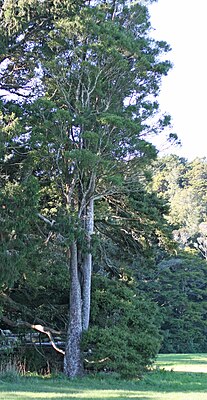Prumnopitys taxifolia
| Prumnopitys taxifolia | ||||||||||||
|---|---|---|---|---|---|---|---|---|---|---|---|---|

Prumnopitys taxifolia |
||||||||||||
| Systematics | ||||||||||||
|
||||||||||||
| Scientific name | ||||||||||||
| Prumnopitys taxifolia | ||||||||||||
| ( Sol. Ex D.Don ) de Laub. |
Prumnopitys taxifolia is a plant from the Prumnopitys within the family of podocarpaceae (Podocarpaceae). It occurs in New Zealand and is also called Black Pine orMataīby the Maori .
description
Vegetative characteristics
Youth form
In contrast to the related species Prumnopitys ferruginea , Prumnopitys taxifolia has a clearly different and long-term youth stage. The young specimens grow as a shrub from thin, flexible twigs that are loosely covered with brown, dull yellow and dirty white needles. After several years, the tree begins to grow from the top of the bush, the branches of which gradually die off and fall off.
Adult form
Prumnopitys taxifolia grows as an evergreen tree that reaches heights of growth of up to 40 meters and trunk diameters of around 2 meters. The needle-shaped leaves are straight to sickle-shaped, 10 to 15 millimeters long and 1.5 to 2 millimeters wide. The needles of the adult form are dark green, slightly frosted on the top and clearly white on the underside.
Generative characteristics
Prumnopitys taxifolia is dioecious separate sexes ( diocesan ). The cones are heavily modified and reduced to a central 3 to 4 centimeter long stalk that carries one to six scales. These each ripen into a berry-like, 10 to 15 millimeter long, purple-purple aril , which is edible and envelops the individual seeds.
ecology
The seeds are spread by the Maori fruit pigeon , which feeds on the aril and excretes the seeds with the droppings.
Occurrence and protection
Prumnopitys taxifolia occurs on the North and South Islands of New Zealand. It thrives at altitudes of 20 to 100 meters.
Until 1970, the populations decreased due to deforestation . As a closed forest, Prumnopitys taxifolia had been pushed back considerably by the use of wood. Only a few closed Mataī forests remained. Since then the stocks have increased again. That is why the IUCN listed “Least Concern” in the list of threatened species in 2011 .
Systematics
The first description was in 1832 under the name ( Basionym ) Dacrydium taxifolium by Joseph Banks and Daniel Carl Solander in David Don : A Description of the Genus Pinus , 2nd edition, Volume 3, page 119. The specific epithet taxifolia refers to the similarity of the needles with the yew trees ( Taxus ). The new combination to Prumnopitys taxifolia was published in 1978 by David John de Laubenfels in Blumea , Volume 24, Issue 1, page 190. Further synonyms for Prumnopitys taxifolia (Banks & Sol. Ex D.Don) de Laub. are: Dacrydium mai A.Cunn. , Podocarpus spicatus R.Br. , Nageia spicata (R.Br. ex Mirb.) F.Muell. , Stachycarpus spicatus (R.Br.) Tiegh.
Prumnopitys taxifolia differs from the similar Prumnopitys ferruginea in the shape of the needles, the color of the fruit and the bark.
use
The wood from Prumnopitys taxifolia was used for flooring in New Zealand in the mid-20th century.
swell
- Christopher J. Earle: Prumnopitys taxifolia. In: The Gymnosperm Database. January 3, 2011, accessed October 31, 2011 .
- Prumnopitys taxifolia. New Zealand Plant Conservation Network, May 3, 2011, accessed October 31, 2011 .
Individual evidence
- ↑ a b c d Christopher J. Earle: Prumnopitys taxifolia. In: The Gymnosperm Database. January 3, 2011, accessed October 31, 2011 .
- ↑ a b c Prumnopitys taxifolia in the IUCN Red List of Threatened Species 2019.1. Listed by: A. Farjon, 2011. Retrieved May 15, 2019.
- ↑ a b Prumnopitys taxifolia at Tropicos.org. Missouri Botanical Garden, St. Louis, accessed May 14, 2019.





